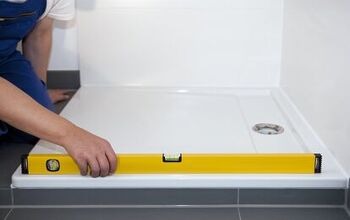Standard Granite Slab Sizes (with Drawings)

The kitchen is one of the biggest selling factors of a house and also one of the most hardworking rooms. Granite countertops are a popular addition to a kitchen, but they can become pricey if you’re not careful. The best way to keep things affordable is to opt for standard granite slab sizes instead of custom dimensions.
Granite slabs come in standard sizes between 9 and 10 feet long and 5 and 6 feet wide. A standard slab has a roughly 45 square foot surface, but the finished countertop will be slightly less after cutting and installation. Suppliers receive between 8 and 10 slabs per bundle, all cut from the same block of granite to ensure uniformity.
You’ll likely need several granite slabs, depending on your particular kitchen project. If you’re simply replacing the counter on a kitchen island, you could potentially use a granite remnant. These smaller pieces are ideal for small tables, backsplashes, or bathroom vanities.
What Are the Standard Granite Slab Sizes?
Opting for standard granite slab sizes is the way to go if you want to keep your remodeling or construction project affordable. When workers extract granite blocks from a quarry, they cut them into thin sheets or slabs.
Granite features unique colors, striations, and patterns, making matching slabs from different places challenging. Therefore, slabs from the same block are placed together in bundles of 8 or 10 slabs before heading to the supplier.
You’ll find standard granite slabs between 9 and 10 feet long and between 5 and 6 feet wide. The exact size often depends on the type of granite.
Some Standard Granite Slab Sizes by Type
| Granite Type | Length | Width |
| Juparana Ming | 114 inches | 65 inches |
| Delicatus White | 114 inches | 69 inches |
| Crema Marfil | 117 inches | 62 inches |
| White Carrara | 112 inches | 65 inches |
| Alaska White | 113 inches | 66 inches |
| Acapulco | 117 inches | 70 inches |
Typically, a single granite slab will have a surface area of about 45 square feet. Keep in mind that this is not the amount of surface area you’ll end up with on your finished counter or tabletop. Before installation, installers usually need to trim the stone to the exact measurements required for a proper fit.
They also smooth out edges and make any necessary cutouts. After all of this work, your resulting surface area will be slightly less than the original area of the rough slab.
What Are Standard Thicknesses of Granite Slabs?
Another important consideration when it comes to granite slabs is the thickness. Just like granite slabs have standard lengths and widths, they also have standard thicknesses. You’ll find ¾-inch thick slabs and 1-¼ inch thick ones.
You’ll more often find thinner slabs in bathrooms. However, you can also use them in the kitchen. These thinner slabs would usually be less expensive and offer a more minimalistic, sleek look.
On the contrary, using the thicker granite in a bathroom could offer a more high-end, luxe feel. When choosing the thickness of your granite, it comes down to your preference and budget.
Also, thinner slabs will weigh less. The 1-¼-inch thick slabs weigh roughly 19 pounds per square foot. Slabs with ¾-inch thickness weigh below 13 pounds per square foot.
What Is the Largest Granite Slab Size?
The largest granite slab would be about 134 inches long and just under 7 feet wide. However, this larger size might not be as readily available as the more standard sizes.
If you know you need a large slab, you would likely need to let your supplier know so they can have the quarry cut the large slab.
What Is the Best Way to Work Standard Granite Slab Sizes In Your Kitchen?
Making the most of your budget and design is all about your layout. You can incorporate standard granite slabs into a kitchen and still create a custom look if you plan it properly.
For example, the average depth of a kitchen countertop is two feet. Imagine you have a 16-foot length counter running along one wall. If you purchase a standard slab that is 5 feet wide by 9 feet long, the installer can cut the slab lengthwise.
In doing so, you end up with two granite slabs, 2.5 feet wide by 9 feet. You can then finish your 16 feet of counter space using this one slab.
If you have a stove breaking up a stretch of counter, you’ll need less granite. Likewise, if you need a cutout for the sink, you could end up with a granite remnant roughly 2 x 3 feet. This remnant could make a cutting board on a different surface or be a small table or bar top.
Example One
In the below example, you could finish this kitchen with two standard granite slab sizes of 9 x 5 feet. You would cut the slab in two lengthwise for the kitchen counters. The stove and fridge are on one side, so 9-feet of granite is more than enough here.
Therefore, the only seam would be the angled one at the corner. The second slab would be used for the island and could stay seamless. You would also end up with a decent-sized remnant.
Example Two
Again, two slabs would finish this project, but you would need the width to be 6 feet this time. Cut one slab lengthwise for your two counters. Then, use the second slab for one solid piece of granite for the kitchen island.
What If You Want a Kitchen Island Larger Than a Standard Granite Slab?
You’ll need two slabs if you want to create a massive kitchen island, longer than 10 feet or wider than 6. Discuss options with your designer about how to minimize the seams best.
For example, do you want a 7-foot wide island? Joining two 3’5″ slabs in the center might look better than having an off-center seam. It’s a matter of preference but think about remnants you’ll get.
Have a solid plan for them (i.e., a bathroom vanity, bar, etc.). You could also replace the top of a storebought island with a granite remnant for an elevated and custom look.
How Much Do Standard Granite Slabs Cost?
The actual granite slab costs between $1,800 and $3,600 (or $40 to $80/square foot). The actual price depends on the type of granite, thickness, etc. However, you could pay between $100 and $400 a square foot for more unique, high-quality, and luxurious varieties.
These prices are for the granite only and don’t factor in additional costs for cutting or installation. These factors can add another $400 to $1,200 or more to your bottom line.
Where Can You Find Leftover Granite Slabs for Sale?
As we mentioned before, when granite gets cut for installation, it creates remnants. Some of these remnants can be quite large. If you’re really on a shoestring budget, you could start your search for leftover granite pieces.
You can find leftover pieces of granite for sale at stone outlets, building suppliers, and similar places. Kitchen and bath remodeling companies and stores might also offer remnants for sale in their showrooms. You can consult with your contractor or do an online search to find specific locations and granite warehouses in your area.
Conclusion: Standard Granite Slab Sizes
Standard granite slabs can save you money when planning a remodeling project that involves granite. You can find standard granite slab sizes 9 to 10 feet long and 5 to 6 feet wide. For bathrooms, the standard ¾-inch thickness if the most common, while the standard 1-¼-thickness is typical in kitchens.
Be thoughtful about your layout when planning your design, as it can save you time and money. You could potentially get multiple countertops out of one slab of granite. It’s also considering what granite slab remnants might be usable in your space.

Stacy Randall is a wife, mother, and freelance writer from NOLA that has always had a love for DIY projects, home organization, and making spaces beautiful. Together with her husband, she has been spending the last several years lovingly renovating her grandparent's former home, making it their own and learning a lot about life along the way.
More by Stacy Randall



























![10 Most Dangerous Neighborhoods in Baltimore [Updated]](https://cdn-fastly.upgradedhome.com/media/2023/07/31/9075655/10-most-dangerous-neighborhoods-in-baltimore-updated.jpg?size=350x220)


